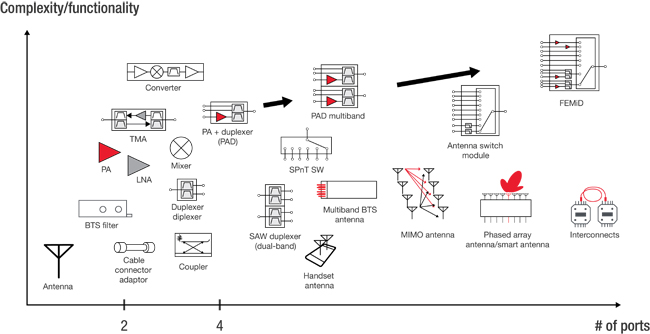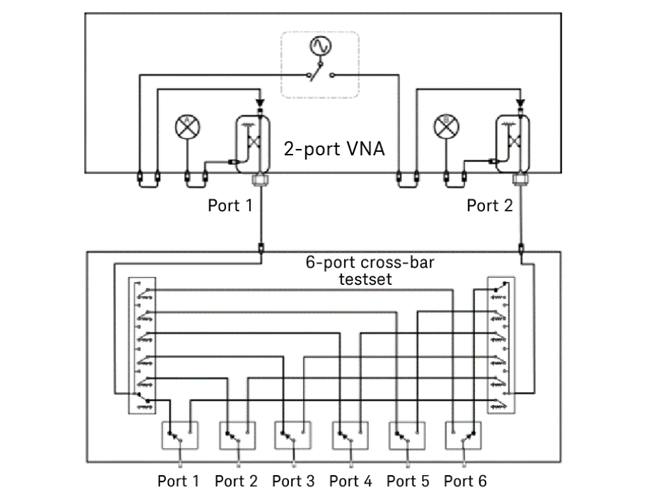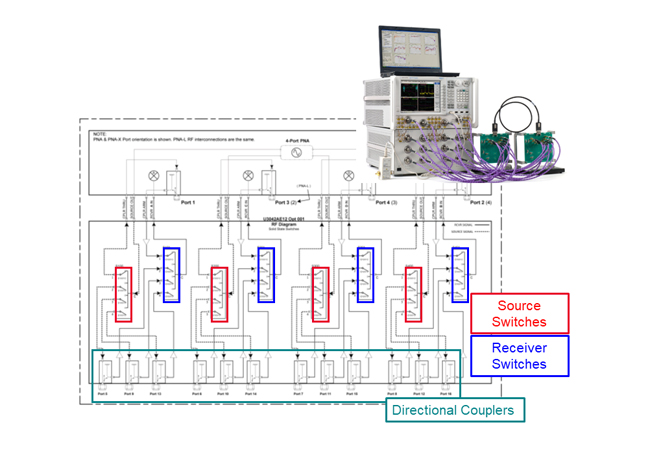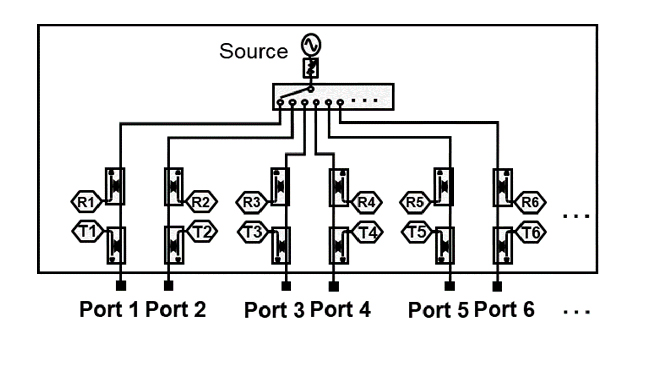Driving down the cost of test is a key challenge in high-volume component manufacturing. The trend towards adding more ports on components such as antennas, cables, and frontend modules (FEMs) increases the need for accurate and fast multiport network analysis. Minimizing operator intervention and reducing connection and calibration times is essential to increase measurement throughput. Optimizing your vector network analyzer (VNA) configuration is critical to minimizing the cost of test in manufacturing. That’s when the multiport and multisite testing concepts come in, but there are challenges. Different multiport test solutions exist, each presenting specific challenges and advantages.
5G augments multiport testing challenges
Today, many components include multiple integrated functions. The number of ports on these components continues to expand and increase in complexity. Examples include multiple-input/multiple-output (MIMO) antennas for base stations, RF FEMs that support multi-band operations in smartphones, and passive interconnect products for high-speed digital applications such as RF connectors and cable assemblies (see Figure 1).

Figure 1. DUT map by complexity and number of ports.
While some multiport devices may be tested as a series of 2-port measurements, many applications require more thorough multiport characterization. An increasing number of measurement parameters for multiport devices also drives component manufacturers’ interest in minimizing total test time in high-volume manufacturing. One way to achieve this is to connect all the ports of the device to a VNA at the same time. However, adding a multiport test system usually means lower accuracy, less error correction capability, and lower system stability.
5G brings additional challenges with the use of massive MIMO and beamforming technologies. These technologies increase energy efficiency and range, and reduce inter-cell interference, but the many elements in a massive MIMO antenna introduce instrument setup, calibration, and measurement challenges.
Simple switching test sets
In the early days of network analysis, all measurements were focused on 2-port S-parameters. As the capabilities of VNAs expanded to test power splitters, mixers, and differential devices, 4-port VNA became more common. Today, a multiport device typically refers to any device requiring more than 4 ports for network analysis. The test setup usually involves a single connection to one device under test (DUT).
The simplest and most common type of multiport test sets is a simple switching test set. Adding switches to a 2-port VNA enables these test sets to handle devices with more than 4 ports, as shown in Figure 2. The setup measures any path from port 1 to port 2, but measurements between ports that branch from the same VNA port are not possible. This type of test set is useful for devices like a multiplexer because a multiplexer has one or more inputs on the left and many outputs on the right, and there is no need to test the thru paths between the input ports, or between the output ports. Devices that require a full matrix of paths need a different multiport test solution.

Figure 2. 2-port VNA with 24-port test set.
Full-crossbar switching test sets
Many multiport devices require measurements from each port to every other port. A full-crossbar switch test set, as shown in Figure 3, provides a full matrix of paths. The general configuration connects sets of 1xN switches to 1x2 switches at each test port allowing the measurement of any path. An internal load in the 1xN switches typically terminate unused ports. You can also perform 2-port error correction between any 2 ports, with the remaining ports internally connected to a load.

Figure 3. 2-port VNA with full crossbar switching test set.
The response to any path in a full-crossbar setup depends on the load match of the other ports though. If your device is not very sensitive to the load match, the load match of the test set may be enough. This is the case when testing isolation on a multiport switch where the load match on one port does not dramatically affect transmission on the other ports. If the load match of the test set is not enough, you need full NxN calibration to correct for the mismatch at each port. This makes calibration more difficult. For example, each of the six test ports in Figure 3 can use two different 1x6 switches for load termination. The switch used for termination on each port also varies depending on which ports are active. You need to calibrate for every case as terminating the port depends on the path selected.
Extension test sets
You can address the need for full NxN calibration with an extension test set, an improved full crossbar design (see Figure 4). Full NxN port calibration corrects the load match for every port and every path in the configuration. The extension test set uses source and receiver switches to extend the VNA source switch matrix to more outputs and the internal receivers to more ports. Each additional port requires an additional test port coupler, but they are available as test ports because the switching occurs behind the VNA directional couplers, increasing the total number of ports available.

Figure 4. 4-port VNA with 12-port extension test set.
Measurement stability and performance is much better with extension test sets than switch test sets because all the switching occurs behind the test port couplers. Switch loss has no effect on measurement stability, but it reduces the dynamic range. You can address this flaw with true multiport VNAs.
True multiport VNAs
True multiport VNA solutions do not require external switching for multiport measurements (see Figure 5). The solution consists of multiple independent VNAs, each containing independent reference and test receivers. Reference and local-oscillator signals are distributed amongst the VNAs to ensure that all the receivers measure at the same frequency. This arrangement enables the simultaneous capture of S-parameter data at all test ports of the multiport system. Measurements are highly accurate and stable because multiport VNAs have minimal loss between the DUT and the measurement receivers. These solutions also deliver faster measurement speed and throughput compared to switch-based test sets due to less measurement sweeps.

Figure 5. Multiport VNA diagram.
As an example, Keysight’s M9800A Series PXI VNA is a full 2-port VNA with a wide frequency range of up to 53 GHz that fits in one PXI slot, or a 4- or 6-port VNA with a frequency range of up to 20 GHz that fits in two PXI slots. Each PXI module is a full VNA. Modules cascade and synchronize to create a single multiport VNA. This VNA supports 66-port configurations up to 20 GHz and 34-port configurations up to 53 GHz. Modular PXI VNAs provide the flexibility and measurement accuracy required for characterizing multiport devices. Measurement speeds are also dramatically faster because each port has its own reference and test receiver. PXI VNAs drastically accelerate multiport device testing by eliminating the switching time required by conventional multiport test sets.
5G test engineers - choose your weapon
Several solutions are available to address the growing need for multiport device testing. Switching test sets provide a relatively low-cost solution to increase the number of ports on a VNA, but loss in the test set switches degrades system performance. Switch-based multiport measurements also require switching signal paths using the VNA receivers, and sequential measurements are necessary to obtain all the S-parameters of multiport devices. In contrast, true multiport VNAs deliver higher performance, faster measurement speed, and reduce the need for periodic recalibrations. Choose your multiport test solution wisely based on your specific needs.
Biography
 Jessy Cavazos joined Keysight's Industry Solutions Marketing team in January 2019 with a focus on 5G. Prior to that, Jessy was the Industry Director for the Test & Measurement practice at Frost & Sullivan. She joined the global consulting and market research company in 2002 and tracked the Test & Measurement industry for more than 15 years. Jessy has authored numerous market studies highlighting key opportunities and disruptive trends and has been published in industry-leading publications. Jessy holds a bachelor’s degree in international business from the Institut de Formation Internationale located in Rouen, France, now part of the NEOMA Business Schools.
Jessy Cavazos joined Keysight's Industry Solutions Marketing team in January 2019 with a focus on 5G. Prior to that, Jessy was the Industry Director for the Test & Measurement practice at Frost & Sullivan. She joined the global consulting and market research company in 2002 and tracked the Test & Measurement industry for more than 15 years. Jessy has authored numerous market studies highlighting key opportunities and disruptive trends and has been published in industry-leading publications. Jessy holds a bachelor’s degree in international business from the Institut de Formation Internationale located in Rouen, France, now part of the NEOMA Business Schools.

